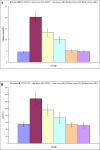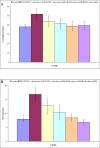Influence of olive leaves extract on hepatorenal injury in streptozotocin diabetic rats
- PMID: 31762669
- PMCID: PMC6864289
- DOI: 10.1016/j.sjbs.2017.02.005
Influence of olive leaves extract on hepatorenal injury in streptozotocin diabetic rats
Abstract
Medicinal plants have always been an important source of new alternative effective compounds for human therapy. Currently, there are many of scientific evidences indicate that the medicinal plants contain a lot of hypoglycemic chemical compounds. The purpose of the present study was to determine the influence of olive leaves extract on hepatorenal injury in diabetic male rats. Experimental diabetes was induced by streptozotocin (STZ). The levels of serum glucose, alanine aminotransferase, aspartate aminotransferase, alkaline phosphatase, gamma glutamyl transferase, total bilirubin, creatinine, blood urea nitrogen, uric acid and malondialdehyde were significantly increased, while the levels of serum superoxide dismutase, glutathione and catalase were statistically decreased in untreated diabetic rats. Moreover, the histopathological examination showed several alterations in the structure of liver and kidney in untreated diabetic rats. Treatments with low dose and high dose of olive leaves extract in diabetic rats showed remarkable reducing and protecting influences of physiological and histopathological alterations. Moreover, the highly treatment efficiency was noted in diabetic rats treated with high dose followed by low dose of olive leaves extract. Additionally, the results of this study proved that the antioxidant activities of olive leaves extract played a vital role against the hepatorenal injury induced by diabetes. Finally, this study indicates to the importance of the use of olive leaves extract as promising alternative and complementary therapeutic agent against diabetes and its complications.
Keywords: Blood; Diabetes; Kidney; Liver; Olive leaves; Rats; Streptozotocin.
© 2017 Production and hosting by Elsevier B.V. on behalf of King Saud University.
Figures







Similar articles
-
Effect of Olea europaea leaves extract on streptozotocin induced diabetes in male albino rats.Saudi J Biol Sci. 2019 Jan;26(1):118-128. doi: 10.1016/j.sjbs.2017.03.002. Epub 2017 Mar 7. Saudi J Biol Sci. 2019. PMID: 30622415 Free PMC article.
-
Antidiabetic and antioxidant potential of Emblica officinalis Gaertn. leaves extract in streptozotocin-induced type-2 diabetes mellitus (T2DM) rats.J Ethnopharmacol. 2012 Jun 26;142(1):65-71. doi: 10.1016/j.jep.2012.04.014. J Ethnopharmacol. 2012. PMID: 22855943
-
Attenuation of diabetic nephropathy in streptozotocin-induced diabetic rats by Punica granatum Linn. leaves extract.J Tradit Complement Med. 2016 Jul 13;7(3):273-280. doi: 10.1016/j.jtcme.2016.06.008. eCollection 2017 Jul. J Tradit Complement Med. 2016. PMID: 28725620 Free PMC article.
-
Therapeutic Potentials of Colocasia affinis Leaf Extract for the Alleviation of Streptozotocin-Induced Diabetes and Diabetic Complications: In vivo and in silico-Based Studies.J Inflamm Res. 2021 Feb 19;14:443-459. doi: 10.2147/JIR.S297348. eCollection 2021. J Inflamm Res. 2021. PMID: 33642871 Free PMC article.
-
Hyptis verticillata attenuates dyslipidaemia, oxidative stress and hepato-renal damage in streptozotocin-induced diabetic rats.Life Sci. 2019 Feb 15;219:283-293. doi: 10.1016/j.lfs.2019.01.027. Epub 2019 Jan 19. Life Sci. 2019. PMID: 30668955
Cited by
-
[Intervention of phlegm and blood stasis inhibits TGF-β1/Smad3 signaling pathway in the kidney of diabetic rats].Nan Fang Yi Ke Da Xue Xue Bao. 2020 May 30;40(5):708-712. doi: 10.12122/j.issn.1673-4254.2020.05.15. Nan Fang Yi Ke Da Xue Xue Bao. 2020. PMID: 32897204 Free PMC article. Chinese.
-
Role of Olive Leaf Extract, Mesenchymal Stem Cells or Low Radiation Dose in Alleviating Hepatic Injury in Rats.Dose Response. 2024 Sep 29;22(3):15593258241289301. doi: 10.1177/15593258241289301. eCollection 2024 Jul-Sep. Dose Response. 2024. PMID: 39483141 Free PMC article.
-
Roflumilast ameliorates diabetic nephropathy in rats through down-regulation of JAK/STAT signaling pathway.Naunyn Schmiedebergs Arch Pharmacol. 2023 Nov;396(11):3285-3297. doi: 10.1007/s00210-023-02535-0. Epub 2023 Jun 15. Naunyn Schmiedebergs Arch Pharmacol. 2023. PMID: 37318524
-
Pharmacological attributes of Bacopa monnieri extract: Current updates and clinical manifestation.Front Nutr. 2022 Aug 18;9:972379. doi: 10.3389/fnut.2022.972379. eCollection 2022. Front Nutr. 2022. PMID: 36061899 Free PMC article. Review.
-
Antidiabetic Effect of Collagen Peptides from Harpadon nehereus Bones in Streptozotocin-Induced Diabetes Mice by Regulating Oxidative Stress and Glucose Metabolism.Mar Drugs. 2023 Sep 29;21(10):518. doi: 10.3390/md21100518. Mar Drugs. 2023. PMID: 37888453 Free PMC article.
References
-
- Ademiluyi A.O., Oboh G. Attenuation of oxidative stress and hepatic damage by some fermented tropical legume condiment diets in streptozotocin-induced diabetes in rats. Asian Pac. J. Trop. Med. 2012;5:692–697. - PubMed
-
- Aebi H. Catalase in vitro. Methods Enzymol. 1984;105:121–126. - PubMed
-
- Akinnuga A.M., Bamidele O., Ebunlomo O.A., Adeniyi O.S., Adeleyea G.S., Ebomuche L.C. Hypoglycaemic effects of dietary intake of ripe and unripe lycopersicon esculentum (tomatoes) on streptozotocin-induced diabetes mellitus in rats. J. Biol. Sci. 2010;10:50–53.
LinkOut - more resources
Full Text Sources

